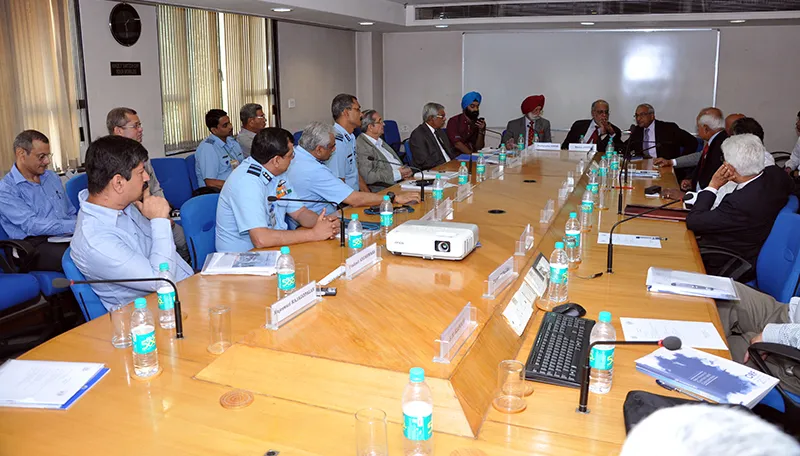-
CENTRES
Progammes & Centres
Location
Pointing out that the problem for an upcoming Indian defence industry is in the basics, experts suggest that a refinement of processes in conducting business and procurement would go a long way.

Pointing out that the problem for an upcoming Indian defence industry is in the basics, experts suggest that a refinement of processes in conducting business and procurement would go a long way.
This suggestion came up during a conference on "Affordable Air Power" organised by Observer Research Foundation and Society for Aerospace Studies at the Delhi ORF campus on 30 October, 2013.
Throughout the conference, participants also criticised the country’s public sector units in the defence sector. It was noted that defence and aerospace is the only sector in India without tax exemptions and incentives.
The delegates began the discussion by noting the current shift in defence expenditures around the world, with defence budgets falling in Europe and North America, and rising in the Asia-Pacific region. From 2009 to 2013, defence expenditure in India totalled around Rs 300 thousand crores. In this context, would India need new business models and alliances to cope with its future defence needs?
The first session of the conference was on "Deciding the Optimum Force Mix". It was noted that air power denotes more than just the air force’s capabilities. It also implies national capability as a whole, which includes R&D, industry and civil aviation. This makes maintaining air power a very capital intensive task. The need for an integrated plan to coordinate all the three services’ procurement needs to decide the optimum force mix was stressed upon.
It was also noted that the strategic environment is a technological environment and ultimately affordability will come with a strategy of control over critical technologies. Any review needs to fundamentally address the national aerospace policy to develop an industrial ecosystem. Moreover, there is a requirement for accountability in projects, and it is critical that unviable projects are shut down at the earliest.
However, some participants claimed that given that affordability and air power are both functions of different variables, picking an affordable air-craft mix is an inexact science. For example, does one define affordability by the cost of the platform itself, or the costs of the weapons and sensors? Is it more affordable to have aircraft that are role-specific or those that have multi-role capabilities? How is affordability related to long term planning?
The second session of the conference was titled "Rationalisation of Weapon Systems & Fleet". The issue of quality improvement was focused upon and it was asserted that if quality is improved, it would lead to an increase in fleet availability, and also reduce lifecycle costs to make the aircraft more affordable. In India there is 99 percent-plus fleet availability in civil airlines today, but only 60 percent in military aircraft. Thus, there is a great potential for improving fleet availability of military aircraft. For quality improvement, a number of shortcomings in the aircraft production process in India. Some of the problematic areas include inability to absorb technology, lack of proper test facilities in India, lack of proper tools and tool design facilities, product support and human resource development.
The best method for deploying available resources in order to get the best value for money was also discussed. It was noted that given the non-linear relationship between capability and cost, and equipment costs skyrocketing, there has also been a subsequent increase in capability. These high costs can be offset to a large extent by enhancing aspects of user-experience like maintainability, reducing downtime, improving performance, and reducing the periodicity of inspection and recalibration. Moreover, the Indian experience of placing reliance on government institutions for defence production has not been positive. Instead of production, the government should focus on control and monitoring.
The last session was on "Cost Effective Solutions & New Partnership Models". The need for new business models was questioned. It was argued that the current licence production model had failed completely and does not support indigenisation. In the coming future, there will be a huge demand for civil and military aircraft in the Asia-Pacific region. But India may not be able to meet that demand through Asian industries with the market still being dominated by the large western producers. It was suggested that the Indian aerospace industry should tap into these opportunities in the commercial sector. Moreover, Foreign Direct Investment is important to build up the Indian industry. India must allow foreign manufacturers to set up wholly owned subsidiaries in India for huge orders like the MMRCA.
The partnership model followed in the USA, called mentor-protégé system, was also highlighted. Large companies have a host of protégé companies who they guide through the process of being viable suppliers. To formalise this procedure high-technology centres of excellence are nominated, whereby they adopt protégés who work in collaboration with them. It was felt that this process can work effectively under the aegis of the government. Today, there is no formal, government mandated policy with regards to this and the results are also not on the table. Without such a policy, Indian industry may find it hard to catch up and move into the future.
(This report is prepared by Arjun Chatterjee, Research Intern, Observer Research Foundation, Delhi)
The views expressed above belong to the author(s). ORF research and analyses now available on Telegram! Click here to access our curated content — blogs, longforms and interviews.